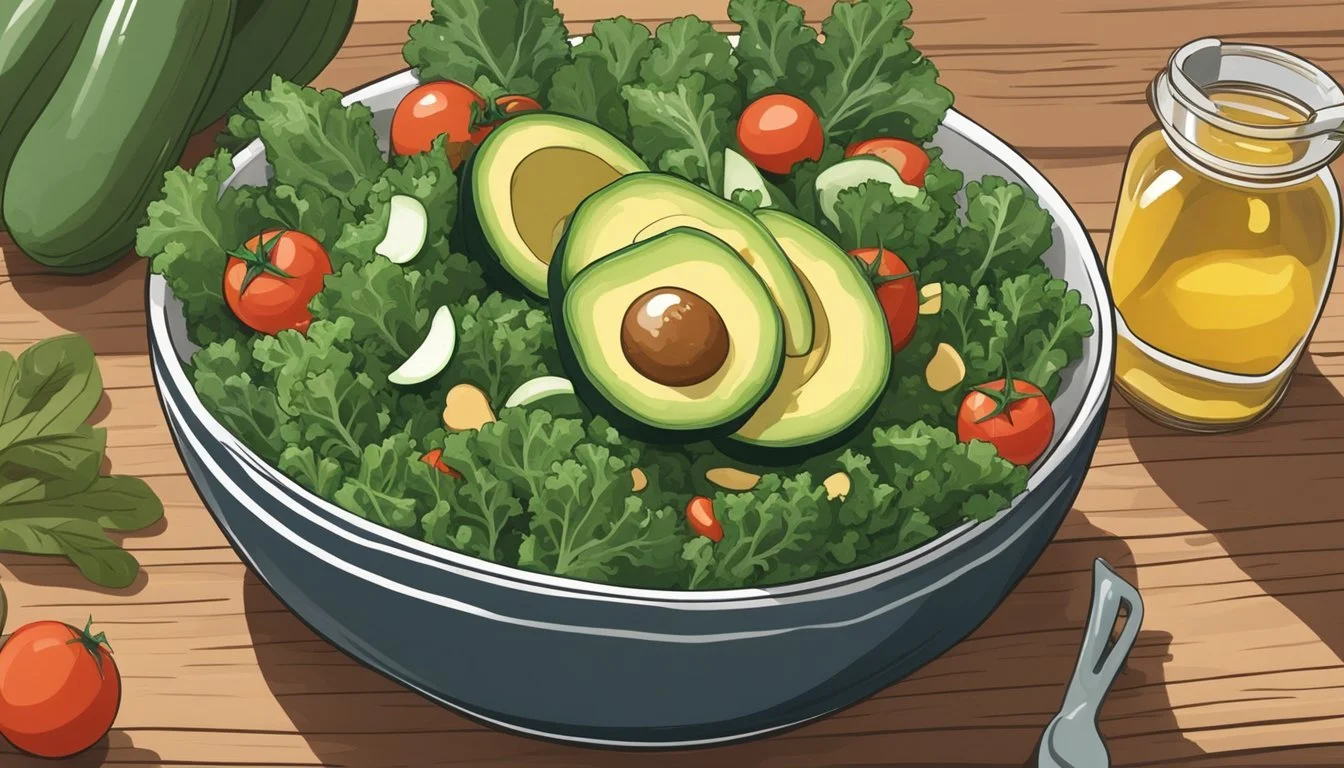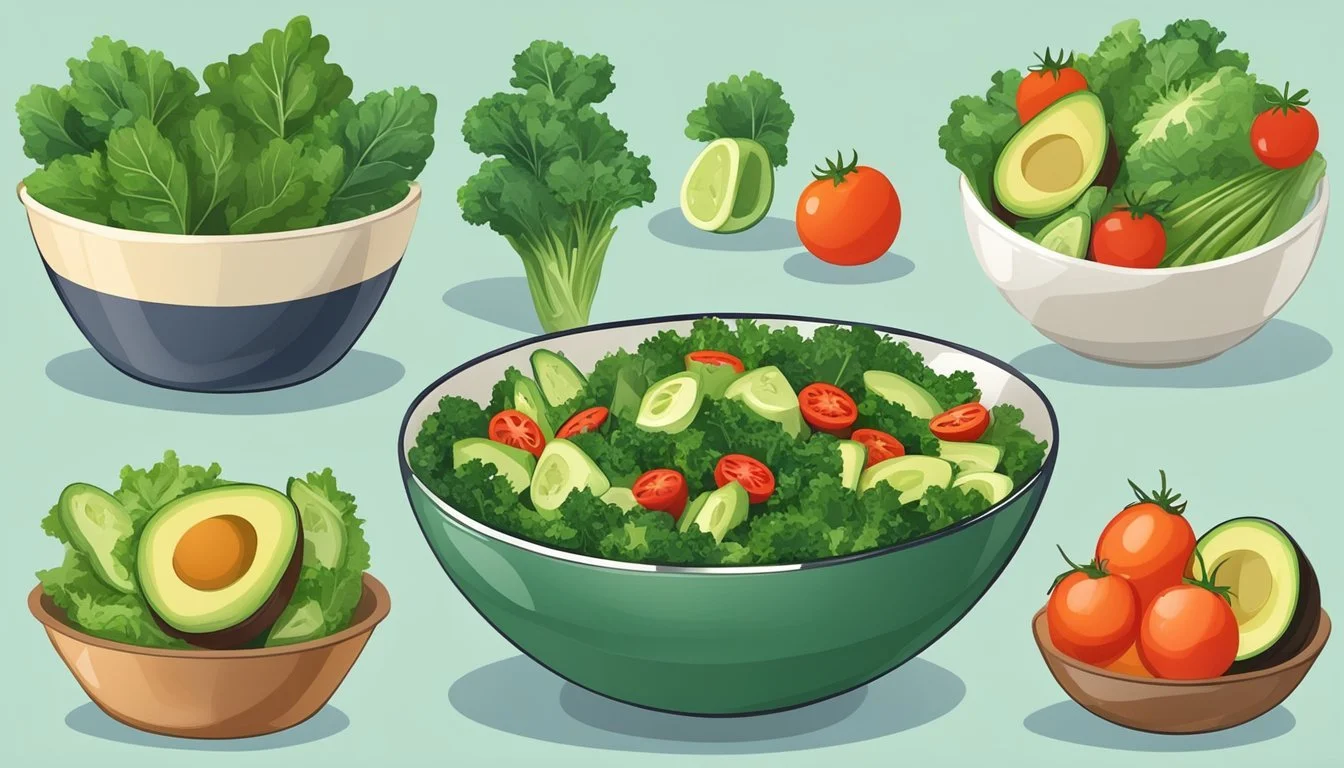How Do You Eat Kale Salad?
Mastering the Art of a Healthy Green Meal
Kale, (What wine goes well with kale?) a leafy green vegetable dense in nutrients, forms an excellent base for salads (What wine goes well with salads?), surpassing its peers in both health benefits and versatility. While raw kale might seem tough and fibrous at first glance, simple culinary techniques transform it into a more tender and enjoyable ingredient. To initiate the process, kale leaves are often massaged, a step that may appear superfluous, but is crucial in softening the texture. The massaging action, which involves kneading the leaves with a bit of dressing, or even just lemon juice and salt, alters the cellular structure of the kale, rendering it less coarse and more flavorful.
Preparing kale salad goes beyond just softening the leaves. Removing the stems, which tend to be particularly rigid, is advised to ensure a more pleasant eating experience. The leaves can then be cut into bite-sized pieces or thin strips, depending on personal preference or the specific recipe being followed. A diverse array of dressings, from a simple mix of lemon juice and olive oil to more elaborate concoctions featuring garlic, parmesan, and spices, can complement the natural taste of kale, enhancing the salad's overall appeal.
When it comes to including kale in one's diet, it is not just the method of preparation that's essential, but also the thoughtful combination with other ingredients that contributes to a well-rounded dish. Eggs, for instance, pair wonderfully with the robust flavor of kale and can be incorporated in various forms, from frittatas to scrambled eggs. Whether opting for kale's intense crunchiness as a contrast against softer ingredients or appreciating its rich green color, kale salads offer a canvas for a myriad of textures and flavors, suiting a range of culinary preferences.
Health Benefits of Kale Salad
Kale salad offers a potent combination of vitamins, minerals, and other beneficial compounds. Its dense nutritional profile supports various aspects of health, and its versatile nature accommodates numerous dietary preferences.
Nutritional Values
Kale is a powerhouse of nutrients. It is particularly rich in vitamins A, C, and K. For instance, a single cup of raw kale provides:
Vitamin A: Essential for eye health and immune function.
Vitamin C: An antioxidant that aids in collagen synthesis and immune defense.
Vitamin K: Crucial for blood clotting and bone health.
Kale also offers minerals such as calcium and potassium, and is a good plant-based source of protein and fiber.
Dietary Advantages
Incorporating kale salad into one's diet presents several advantages, especially for those following specific dietary plans:
Vegetarian: Kale is great for vegetarians due to its high protein content relative to other greens.
Gluten-Free: Naturally gluten-free, kale is safe for individuals with gluten intolerance or celiac disease.
Antioxidants: The antioxidants present in kale help combat oxidative stress in the body.
Digestion and Texture
Kale's fiber content supports healthy digestion, contributing to regular bowel movements and satiety. While raw kale is naturally chewy and dense, the salad preparation can enhance its texture:
Massaging Kale: A technique that involves kneading the leaves with a bit of olive oil and salt to break down the fibers, making the kale more tender.
Combating Bitterness
Kale’s bitter taste might be off-putting to some, but it can be mitigated by:
Lemon Juice: Adding lemon juice not only helps in reducing bitterness but also provides additional vitamin C.
Pairings: Combining kale with sweeter or creamy ingredients, such as fruits or a tahini dressing, can balance out the flavor.
Ingredient Synergies
A kale salad's health benefits can be amplified by the inclusion of synergistic ingredients. Additions such as:
Nuts and Seeds: Introduce healthy fats and additional protein.
Fruit: Offers natural sweetness and extra fiber.
Lemon and Olive Oil: The vitamin C in lemon enhances iron absorption from kale, while olive oil provides heart-healthy fats.
Preparation Essentials
Preparing a tasty kale salad entails selecting suitable varieties, prepping the ingredients accurately, and employing the right techniques to make the kale palatable.
Selecting Kale Types
When choosing kale, the variety matters for both flavor and texture. Curly kale is common and has a pleasant, peppery flavor. Tuscan kale, also known as lacinato or dinosaur kale, is darker and sweeter, with a more tender texture ideal for salads. Baby kale offers a milder taste and requires less preparation. Lastly, green kale is a versatile choice that holds up well in a salad.
Ready the Ingredients
To begin, gather your vegetables, ensuring they are fresh. Always wash kale thoroughly to remove dirt and potential pesticides. This can be done by immersing the leaves in water, agitating them to loosen grit, then lifting them out and rinsing under cold running water. To prepare kale, strip the leaves from the thick stems, as these are tough and inedible in a raw salad. The leaves should then be chopped to manageable sizes, typically 1/2"-1" pieces.
Kale Treatment Techniques
Massaging kale is an essential step to soften its fibrous texture. Lightly coat the leaves in a mixture of olive oil and salt, or lemon juice, and massage them with your hands until they start to wilt, becoming tender and easier to digest. This process also helps make the raw kale more amenable to absorbing flavors from dressings and other salad ingredients. Depending on your taste preference and dietary requirements, different oils and seasonings may be used for massaging.
Crafting the Perfect Dressing
Crafting the perfect dressing for a kale salad is essential to enhance its flavors. The dressing not only adds taste but also helps in tenderizing the kale leaves.
Oil and Acidity Balance
A well-crafted dressing requires a balance between oil and acidity to complement the robust nature of kale. Extra virgin olive oil is a popular choice for its richness and health benefits. When paired with an acid such as lemon juice or vinegar, the oil's heaviness is lightened, creating a harmonious flavor profile. The standard ratio for a balanced vinaigrette is three parts oil to one part vinegar or citrus juice, ensuring that the oil mellows the tang of the acidity while neither element overpowering the other.
Recommended Ratio:
Oil (e.g., olive oil, extra virgin olive oil): 3 parts
Acidity (e.g., lemon juice, vinegar): 1 part
Enhancing Flavors
To enhance the natural flavors of kale and the chosen oils and acids, one can incorporate ingredients like honey for sweetness, and Dijon mustard for a tangy depth. Salt and pepper are foundational seasonings; using sea salt or kosher salt can provide a cleaner taste. Finely minced garlic adds a pungent kick that can elevate the overall dressing profile, while cheese, such as grated Parmesan, can offer a salty, umami punch, integrating well with other components in the vinaigrette.
Flavor Enhancers:
Sweetness: Honey
Tang: Dijon mustard
Seasoning: Kosher salt, Freshly ground black pepper
Spice: Minced garlic
Umami: Grated cheese (e.g., Parmesan)
Dressing Variations
The versatility of kale salad dressings allows for a range of variations. A classic vinaigrette leverages olive oil and vinegar, often balsamic or apple cider vinegar, as key ingredients. One may encounter creamy dressings combining olive oil with emulsified ingredients like soaked cashews. Lemon-based dressings utilize fresh lemon juice to impart a bright, citrusy flavor to the salad.
Popular Dressing Types:
Vinaigrette: Use a combination of olive oil, vinegar (balsamic or apple cider), and optional sweeteners like honey.
Creamy Variations: Blend soaked cashews with olive oil and lemon juice for a creamier consistency.
Citrusy Option: Fresh lemon juice as the acidic base, with olive oil and seasonings.
Adding Complementary Textures
In creating a kale salad, the inclusion of varied textures can transform it from a simple dish to a complex and satisfying meal. Ensuring a balance of crunchy, soft, and hearty elements brings contrast and depth to each bite.
Crunchy Elements
Crunchy ingredients add a satisfying snap to the kale's natural chewiness. Here are specific components known for their crunch:
A recommended approach is scattering a handful of roasted nuts such as almonds or walnuts on top of the salad. This not only contributes to the crunch but also provides healthy fats.
Soft Components
Soft textures can provide a creamy or tender counterpoint to the kale. Here are some staple soft additions:
Cheeses:
Goat cheese
Burrata
Ricotta
Feta cheese
Fruits and Vegetables:
Dried cranberries
Using avocado gives a buttery consistency that complements the leafy greens, while cheeses like crumbled feta or dollops of goat cheese offer a soft, melt-in-your-mouth sensation.
Grains and Legumes
They can serve as both a protein source and a satisfying textural component. Some ideal options include:
Grains:
Quinoa (What wine goes well with quinoa?)
Farro
Legumes:
Chickpeas
One could mix in cooked quinoa (how long does cooked quinoa last?) or farro for a nutty bite, or integrate chickpeas for a more robust meal. These grains and legumes not only enrich the salad with their textures but also contribute to its nutritional profile.
Incorporating Additional Produce
Expanding the flavor profile of a kale salad is straightforward when fresh or dried fruits (What wine goes well with dried fruits?) and a variety of vegetables are added. Beyond basic greens, these additions introduce new textures, colors, and tastes that can transform a simple salad into a more complex and enjoyable dish.
Fruit Infusions
Incorporating fruits into kale salads enhances sweetness and provides a refreshing balance to the hearty green. Here are specific fruits to consider:
Apples: Crisp and tangy, apples add a juicy crunch. Dice or slice for easy mixing.
Pears: Soft, sweet, and subtly flavored, pairs well with kale's robust texture.
Blueberries: Offer a burst of flavor and color, as well as antioxidants.
Dried Fruits: Such as dried cranberries or golden raisins, contribute a concentrated sweetness and chewy texture.
Vegetable Varieties
Adding a range of vegetables not only contributes vital nutrients but also layers of flavor and crunch. Some vegetable add-ins and pairings include:
Veggies: Consider tossing in shredded carrots, fennel (how long does fennel last?), or cherry tomatoes.
Brussels Sprouts: Roasted and sliced thin, they add depth to the salad's flavor.
Sweet Potato: When roasted and diced, it offers a caramelized, tender element.
Salad Boosters
Certain ingredients can elevate the humble kale salad into a hearty meal or a standout side. To do so, one might introduce:
Avocado: Creamy and full of healthy fats, adding diced avocado can provide richness.
Red Onion: Thinly sliced, it brings pungent sharpness that can awaken other flavors.
Nuts and Seeds: A sprinkle of these can add a nutritious crunch, heightening the texture and taste.
Flavor Enhancers and Toppings
Enhancing the flavor of a kale salad is essential for a satisfying meal experience. The right combination of cheese, proteins, and sweet or savory add-ons can transform a simple kale salad into a culinary delight.
Cheese Selections
When considering cheese for kale salad, one has options ranging from sharp and salty to creamy and mild.
Parmesan: Shaved or grated, it adds a salty bite.
Goat Cheese: Its creamy texture and tang complement kale well.
Burrata: Offers a lavish, creamy addition.
Feta Cheese: Crumbled feta provides a briny touch.
Proteins and Fats
Balancing kale's robust texture with proteins and healthy fats can create a more fulfilling dish.
Nuts and Seeds: Walnuts, pine nuts, or pumpkin seeds lend crunch and substance.
Olive Oil: A quality extra virgin olive oil serves as a healthy fat that enriches the kale's flavor.
Salmon or Shrimp: Either option, whether grilled or sautéed, can serve as a hearty protein to anchor the salad.
Sweet and Savory Add-ons
Combining sweet and savory elements can play against the bitterness of kale for a more complex profile.
Fruits: Chopped apples or dried fruits like cranberries add natural sweetness.
Avocado: Slices or cubes contribute creaminess and a hint of rich, nutty flavor.
Red Pepper Flakes or Honey: For a kick of heat or a touch of sweetness, respectively.
Serving Suggestions
When preparing kale salad, it's important to consider not just the flavor but also the presentation and how it complements the accompanying dishes. Proper storage is crucial to keeping the salad fresh and vibrant.
Presentation Tips
To maximize the appeal of a kale salad, massaging the kale is a crucial step. This process involves physically softening the leaves to make them more palatable and easier to eat, resulting in a dark green and fragrantly inviting bed of kale. Aesthetically, pairing the rich green with bright ingredients like cherry tomatoes, diced bell peppers, or thinly sliced radishes can create a visually stunning dish. Consider garnishing with toasted nuts or seeds for added texture.
Pairing with Main Courses
Kale salad stands well as a centerpiece or as a side dish. As a side dish, it pairs nicely with whole grain options such as quinoa salad or complex carbohydrates like sweet potato fries or crispy potato bites. For a heartier meal, complement a kale Caesar salad with grilled chicken or fish. Addition of protein-rich quinoa can also elevate a simple kale salad to a fulfilling main course.
Storing for Freshness
If the kale salad is a make-ahead dish, dressing it close to serving time helps maintain the best texture. Store the massaged kale in the refrigerator in an airtight container. This can keep it fresh for several days. For mixed salads, they are best consumed on the day they are prepared, but if it's necessary to store them, separate wet ingredients like tomatoes or cucumbers to prevent sogginess.
Recipe Variations and Ideas
Kale salads are versatile, allowing for numerous variations that cater to different tastes and dietary needs. Whether one prefers a simple mix or an ensemble of gourmet ingredients, they can find a way to enhance the hearty greens of kale.
Kale Salad Base Recipes
A fundamental kale salad recipe involves massaging the kale with a bit of olive oil and lemon juice or vinegar, which softens the leaves and reduces bitterness. For an easy kale salad, one might simply add toasted nuts, parmesan cheese, and a light vinaigrette. To make it a make-ahead option, one can keep the dressing separate until ready to serve.
Basic ingredients for foundational kale salad:
Kale (massaged)
Olive oil
Lemon juice or vinegar
Salt and pepper
Innovative Combinations
They can explore creative blends by adding fruits like apple slices or dried cranberries for sweetness or tossing roasted squash or sweet potatoes for a seasonal twist. An interesting kale salad variation might include quinoa or farro for added texture and heartiness.
For textures and flavors, consider infusing:
Fruits: apples, dried cranberries, pomegranate seeds
Roasted vegetables: squash, sweet potatoes
Grains: quinoa, farro
Special Diet Adaptations
Kale salad recipes can easily be adapted to fit special diets. For a vegetarian option, include nuts for protein or even dairy-free cheese alternatives. Gluten-free adaptations are straightforward by ensuring that no gluten-containing toppings or dressings are used.
Special diet options:
Vegetarian: nuts, seeds, dairy-free cheese
Gluten-free: ensure gluten-free dressings and croutons
Meat and Seafood Integrations
For added protein, incorporating meats such as shredded chicken, or seafood like salmon and shrimp, turns a simple kale salad into a full meal. One can grill, bake, or poach proteins before adding to the greens to maintain the salad's freshness.
Protein additions to consider:
Poultry: shredded chicken
Seafood: salmon, shrimp
Tips and Tricks
In making kale salads, the right techniques can transform the tough leaves into a tender, flavorful meal. These tips focus on the importance of massaging the kale, incorporating flavors that complement its earthy taste, and offering inventive ways to present this nutritious green.
Massaging Techniques
Massaging kale is a crucial step in softening the leaves, making them easier and more enjoyable to eat. For effective massaging, one can use:
Sea salt or lemon juice: These help to break down the fibrous texture.
Clean hands: To massage, one would scrunch the leaves thoroughly until they become fragrant and darken, signaling that they are well massaged and less coarse.
Enhancing Ingredient Flavors
Kale's robust flavor pairs well with a variety of ingredients that enhance its taste:
Garlic: Adds a sharp, aromatic kick that complements kale's earthiness.
A simple dressing of lemon juice and sea salt can elevate the salad without overwhelming the taste of the kale.
For added crunch and flavor, one can consider topping the salad with homemade croutons or toasted chips.
Creative Serving Ideas
Salads need not be the only way to enjoy kale; there are innovative serving ideas to consider:
Kale can be a hearty addition to stews or soups, where it contributes both texture and nutrition.
Alternatively, use massaged kale as a base for building a more substantial meal, incorporating proteins or grains to satisfy bigger appetites.
Conclusion
Eating kale salad is both a nutritious and versatile experience, presenting a canvas for an array of textures and flavors. To ensure kale's tough leaves become palatable, massaging the leaves with a mixture of lemon juice and olive oil is an effective technique. This process breaks down the cell walls, resulting in a softer texture and a somewhat sweeter taste.
Incorporating a variety of toppings such as nuts, seeds, dried fruits, or grated cheese enhances the salad, contributing to a complex flavor profile and additional nutrients. For those who seek a richer flavor, a hearty dressing of olive oil combined with lemon juice, garlic, and herbs can elevate the dish.
When preparing kale, one should always remove the tough stems and chop the leaves finely. Options such as lacinato or Tuscan kale are preferred for their texture and ease of preparation.
A kale salad can be as simple or as elaborate as one desires. It stands as a testament to the flexibility of kale as an ingredient, capable of being the cornerstone of a quick lunch or an elaborate dinner side. When preparing kale salad, individuals are encouraged to experiment with ingredients and dressings to discover their unique favorite combinations.





